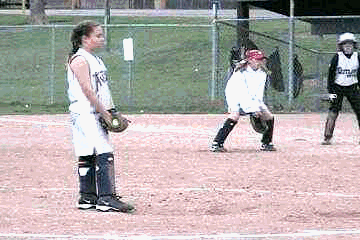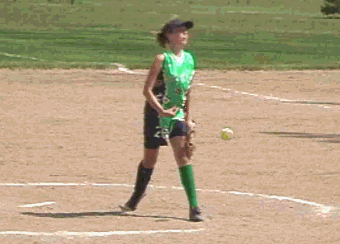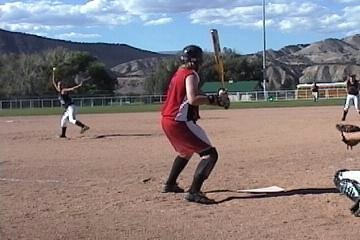|
by Gerald Warner,
Softball Pitching Instructor

You have
been pitching for a few months and are asking "What comes
next?". You are past the "beginner" stage, have a good grasp
of the fundamentals, and have pretty good control of your
fastball. Hopefully, your mechanics are smooth and are
feeling more routine each time you practice. So now you feel
like you want to start throwing some different kinds of
pitches. 
Here is our best advice:
Don't try to go too fast! Too many
promising young pitchers (and their parents)
get lured into trying to learn how to throw a curve, a
screw ball, or a rise ball long before they are
ready. At virtually every tournament we run into some
parent or 12-year old pitcher who brags that she has five
different pitches. But in the game, all her pitches look
alike...and most disheartening is that she has 45mph fastball that
she doesn't control very well.
Just
because you saw a video, or a pitching coach showed you how to
grip and release a pitch does NOT mean that you have mastered
it. Rise balls don't rise when they are thrown at
45mph (unless you throw into a gale-force
headwind).
Before she is
comfortable enough to throw a newly-learned breaking pitch
(drop, curve, screw, rise ) in a game, a
typical young pitcher works on it for months...usually
requiring several thousand practice pitches. It is fun
to have something to brag about, but bragging about a repertoire
of pitches that don't work is harmful to a pitcher. Learn
everything there is to know about a new pitch, practice it one
pitch at a time, and don't use it in a game until it works (it
breaks, is thrown at the right speed, and goes over the plate in
the intended location) at least 70% of the
time.
We encourage our
students to get into a new pitch ONLY if and
when they are ready. Although it can vary for each
student, here is our typical list of pitches to learn and
perfect one at a time:
(1)
Learn...and develop...a GOOD change-up
A good deceptive off-speed pitch can be your best
weapon. It is great to have a pitch that is a dramatic change
from your fastball, but most important a change-up is a controlling
pitch...it is your psychological tool to use with a batter.
Regardless of the speed of your fastball, a well-thrown
change-up can increase your effectiveness more than
50%!
The speed of the
change-up should be about ¾ (70% to 80%) of the speed of your
fastball…which means at least 12 to 15 miles
per hour slower. There are several ways to throw a
change-up (stiff wrist, circle change, flip, knuckle,
etc.) each with your normal motion and arm
speed. Grip the ball far back in your
hand. You need to release it with NO wrist snap…keep your
wrist locked. The idea is to not let the batter know the ball will
be coming in slower. Your facial expression and your windmill
delivery need to look exactly the same as your fastball. Make
certain your coach and your catcher don't always call the change-up
only when you have two strikes on the batter. Mix up your
pitches…sometimes use the change-up on the first pitch… sometimes on
a 2-ball, 1-strike count, etc.
Count on a minimum of 4 months to
learn to throw a deceptive change-up. As we said
before, any new pitch that you learn… a change-up,
a drop ball, and a rise ball…might each take up to 10,000 pitches
before you get it working right. Be patient. Work
hard to make each pitch work the way it supposed to. 
(2) Develop a drop ball. Then
consistently work on it to make it REALLY drop every
time.
A good drop ball can be very effective because it drops below
the batter's bat, making her either hit only the top of the ball for
a grounder, or hopefully, swing totally over the ball.
You need to give the ball a fast
top-to-bottom spin as it goes toward the
plate.
There are two basic ways of releasing a drop
ball:
PEEL DROP - Throw it
like your fastball, but keep your upper body over your toes when you
release it, "peel" or snap it up, off the tips of your
fingers, to create the fast forward
spin.
ROLL-OVER DROP - This
one requires good wrist action to release the ball by "snapping" it
over to create the fast spin. Depending on the
student and her physical ability, we generally start
teaching the roll-over only with pitchers near or at high
school age. 
(3) Learn to throw
one more pitch that works…a curve, screwball, or
rise.
A curve
ball can be effective if it is really deceptive, and really
curves. The primary problem with a curve is that it is thrown
on the same level as the batter swings. Even if it curves a
little, it is still "hittable."
A good rise ball
can be your most effective pitch…provided you
can make it work every time. Thrown
right, it will rise just before it gets to the plate, forcing the
batter to swing under it…popping it up, or missing it
altogether. If it doesn't work right, you will give the batter
a fat pitch up in her power zone. It will take a lot of
practice…many months…to develop a good, effective rise ball.
Even many college pitchers cannot throw a good rise that works
consistently.
A screwball is a pitch, that when
thrown by a right-handed pitcher, curves IN on a right-handed
batter. It looks like it is coming across the heart of plate,
then it moves in toward the batter's hands. It IS
possible to throw a screwball that also rises.
(4) Make
all of your pitches look the same to the
batter.
A batter should not be able
to tell what kind of pitch you are going to throw. Keep the
ball hidden by your glove. Don't show your grip until you
start your backswing. Don't "telegraph" which pitch you are
going to thrown by using a certain facial expression or a different
motion.
(5) To gain
confidence, throw 600 (or more)
pitches each week.
Never
let more than 2 days go by without practicing your fastball,
offspeed, and breaking pitches. Practice alone doesn't make
perfect. Perfect practice makes
perfect. Throw every practice pitch one pitch
at a time. With each one, work to make it better
than the last.
(6) Learn to stay cool; show batters YOU are in
control.
Never let them see you
sweat.
Do you want to reprint this article or use it
on your website or in your newsletter?
As long
as it is not for profit, our only requirement is that you first
notify us, then include the following sentence:
Article by Gerald Warner of
PitchSoftball.com
and include a reference to this
website: www.pitchsoftball.com
If you have questions or need more
information
E-mail us, or
call Pitching Instructor Gerald Warner in Colorado at
(720) 200-4575
Home
Page | | About Us | E-Mail
Us
More for 1st & 2nd Year Pitchers | Beginning Pitchers | Advanced
Pitchers | Coaches and
Parents | 





